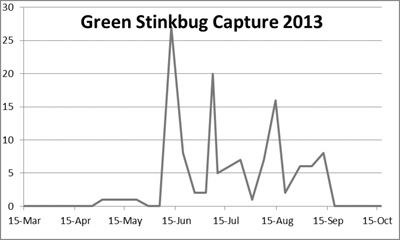|
Big Season For Green Stink Bugs In Soybeans?
DR. DOUG JOHNSON
PRINCETON, KY.
If you’re not checking for stink bugs in your soybeans, you should. This year appears to be producing an extra large population of green stink bugs, at least in western Kentucky. For example, as of July 10, 2015, a total of 2,184 stink bugs have been captured in a black light trap on the UK Research and Education Center (UK-REC) in Princeton, Kentucky. That is more stink bugs than were captured in all of last year (2014) in TWO black light traps at the UK-REC (e.g. 121 + 695 = 816). In fact, more stink bugs were captured in the 2015 single trap (week ending on June 26) than in all of 2014. However one looks at it, that is a lot of stink bugs. In addition, you will notice a great deal of difference between the captures at the North Farm in Lexington versus the UK-REC in Princeton. This occurs almost every year, but it is particularly apparent this year.
We have seen a decrease in capture since that high count, but don’t let that fool you as the numbers will likely rise again. Because the bugs must be able to fly to the trap to be captured, and juveniles do not have wings, black light traps only capture adult stink bugs. Normally, we would expect to see three generations in each summer season. Sometimes this produces very distinct populations (Figure 1), but often the generations tend to show overlap with one another.
We expect stink bugs to begin moving into soybeans as plants begin to bloom. The most important damage will usually occur between R4 (Full Pod) and about R6 (Full Seed).
Sampling for Stink Bugs
Sampling for stink bugs may be done by sweep net or shake cloth. In Kentucky, most of our beans are in narrow rows, so the sweep net is the tool most often used. For sweeping, use a 15-inch sweep net and make 25 sweeps. Then count the number of stink bugs present. Most of the stink bugs will be green, but there may also be brown stink bugs. In addition, juvenile stink bugs may be multi-colored. You can tell them from the adults because they do not have wings. Additionally, you will likely see some brown stink bugs whose shoulders come to a very definite sharp point. These are spined-shoulder bugs and are predators. They will not harm the plants. With the exception of spined-shoulder bugs, count all stink bugs as the same.
If using a shake cloth, lay a 4-foot long cloth between two rows of soybean, then shake the beans on both sides over the cloth. Quickly count the stink bugs that are deposited on the ground cloth. Remember the adults can fly, so do this quickly so you don’t miss the ones that are flying away.
One needs to sample at several locations across the field. Stink bugs are known to be more common on the edges of fields. If you do not sample the middles, then you are likely to overestimate the population.
Economic thresholds for stink bugs are: two stink bugs per 4-row-feet using a shake cloth. So, to meet the threshold, one would need to count 4 stink bugs in a sample. For sweep net samples, the threshold is 3 stink bugs per 25 sweeps from beginning bloom to beginning pod (R1-R3) or 9 stink bugs per 25 sweeps from full pod to full seed (R4 to R6).
One needs to be especially watchful this year as we have so many late planted beans. Soybeans planted at the normal planting dates are much less likely to suffer economically important damage than are later planted beans. Additionally, it is clearly the case that the western third of Kentucky has larger populations than Central or Eastern Kentucky. This has been true for all 4 years of our black light sampling and is especially obvious this year.
UK Trap Counts
You can keep track of stink bug black light trap captures by checking the UK-IPM pages. A graphic form may be viewed by clicking on “StinkBugs.” A table with the actual count data may be viewed by clicking on “All Counts in Table Format.” The stink bug data are last in this list.
Management
If you encounter populations that require an insecticidal control, products available for use against stink bugs may be found online in Insecticide Recommendations for Soybeans-2015 (ENT-13). This publication is also available at your county Extension office. ∆
DR. DOUG JOHNSON: Extension Entomologist, University of Kentucky

|
|